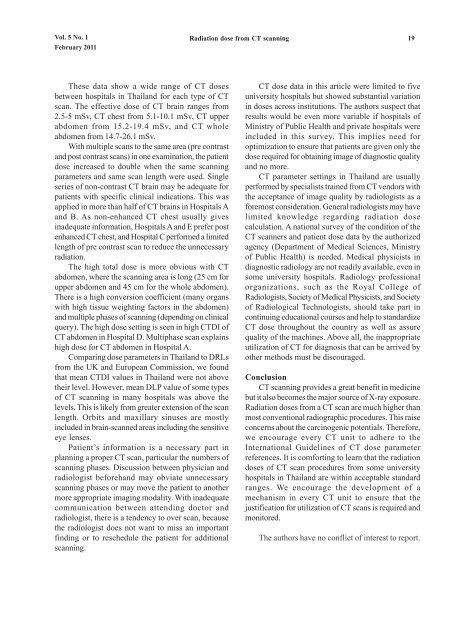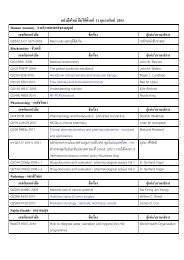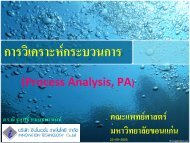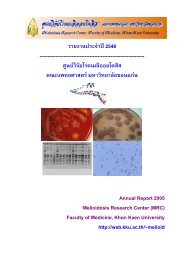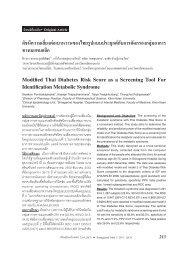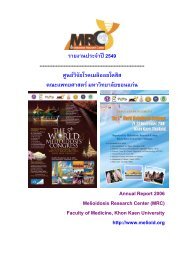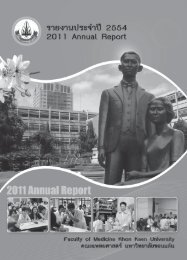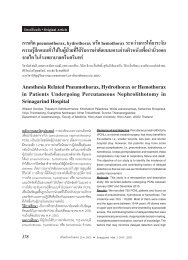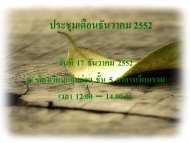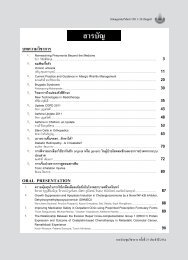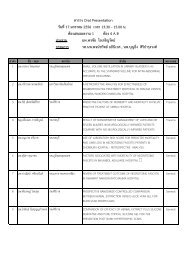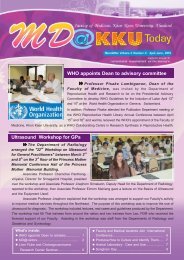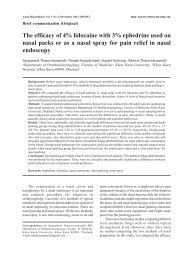Radiation dose from CT scanning: can it be reduced?
Radiation dose from CT scanning: can it be reduced?
Radiation dose from CT scanning: can it be reduced?
You also want an ePaper? Increase the reach of your titles
YUMPU automatically turns print PDFs into web optimized ePapers that Google loves.
Vol. 5 No. 1February 2011<strong>Radiation</strong> <strong>dose</strong> <strong>from</strong> <strong>CT</strong> <strong>s<strong>can</strong>ning</strong>19These data show a wide range of <strong>CT</strong> <strong>dose</strong>s<strong>be</strong>tween hosp<strong>it</strong>als in Thailand for each type of <strong>CT</strong>s<strong>can</strong>. The effective <strong>dose</strong> of <strong>CT</strong> brain ranges <strong>from</strong>2.5-5 mSv, <strong>CT</strong> chest <strong>from</strong> 5.1-10.1 mSv, <strong>CT</strong> upperabdomen <strong>from</strong> 15.2-19.4 mSv, and <strong>CT</strong> wholeabdomen <strong>from</strong> 14.7-26.1 mSv.W<strong>it</strong>h multiple s<strong>can</strong>s to the same area (pre contrastand post contrast s<strong>can</strong>s) in one examination, the patient<strong>dose</strong> increased to double when the same <strong>s<strong>can</strong>ning</strong>parameters and same s<strong>can</strong> length were used. Singleseries of non-contrast <strong>CT</strong> brain may <strong>be</strong> adequate forpatients w<strong>it</strong>h specific clinical indications. This wasapplied in more than half of <strong>CT</strong> brains in Hosp<strong>it</strong>als Aand B. As non-enhanced <strong>CT</strong> chest usually givesinadequate information, Hosp<strong>it</strong>als A and E prefer postenhanced <strong>CT</strong> chest, and Hosp<strong>it</strong>al C performed a lim<strong>it</strong>edlength of pre contrast s<strong>can</strong> to reduce the unnecessaryradiation.The high total <strong>dose</strong> is more obvious w<strong>it</strong>h <strong>CT</strong>abdomen, where the <strong>s<strong>can</strong>ning</strong> area is long (25 cm forupper abdomen and 45 cm for the whole abdomen).There is a high conversion coefficient (many organsw<strong>it</strong>h high tissue weighting factors in the abdomen)and multiple phases of <strong>s<strong>can</strong>ning</strong> (depending on clinicalquery). The high <strong>dose</strong> setting is seen in high <strong>CT</strong>DI of<strong>CT</strong> abdomen in Hosp<strong>it</strong>al D. Multiphase s<strong>can</strong> explainshigh <strong>dose</strong> for <strong>CT</strong> abdomen in Hosp<strong>it</strong>al A.Comparing <strong>dose</strong> parameters in Thailand to DRLs<strong>from</strong> the UK and European Commission, we foundthat mean <strong>CT</strong>DI values in Thailand were not abovetheir level. However, mean DLP value of some typesof <strong>CT</strong> <strong>s<strong>can</strong>ning</strong> in many hosp<strong>it</strong>als was above thelevels. This is likely <strong>from</strong> greater extension of the s<strong>can</strong>length. Orb<strong>it</strong>s and maxillary sinuses are mostlyincluded in brain-s<strong>can</strong>ned areas including the sens<strong>it</strong>iveeye lenses.Patient’s information is a necessary part inplanning a proper <strong>CT</strong> s<strong>can</strong>, particular the num<strong>be</strong>rs of<strong>s<strong>can</strong>ning</strong> phases. Discussion <strong>be</strong>tween physician andradiologist <strong>be</strong>forehand may obviate unnecessary<strong>s<strong>can</strong>ning</strong> phases or may move the patient to anothermore appropriate imaging modal<strong>it</strong>y. W<strong>it</strong>h inadequatecommunication <strong>be</strong>tween attending doctor andradiologist, there is a tendency to over s<strong>can</strong>, <strong>be</strong>causethe radiologist does not want to miss an importantfinding or to reschedule the patient for add<strong>it</strong>ional<strong>s<strong>can</strong>ning</strong>.<strong>CT</strong> <strong>dose</strong> data in this article were lim<strong>it</strong>ed to fiveunivers<strong>it</strong>y hosp<strong>it</strong>als but showed substantial variationin <strong>dose</strong>s across inst<strong>it</strong>utions. The authors suspect thatresults would <strong>be</strong> even more variable if hosp<strong>it</strong>als ofMinistry of Public Health and private hosp<strong>it</strong>als wereincluded in this survey. This implies need foroptimization to ensure that patients are given only the<strong>dose</strong> required for obtaining image of diagnostic qual<strong>it</strong>yand no more.<strong>CT</strong> parameter settings in Thailand are usuallyperformed by specialists trained <strong>from</strong> <strong>CT</strong> vendors w<strong>it</strong>hthe acceptance of image qual<strong>it</strong>y by radiologists as aforemost consideration. General radiologists may havelim<strong>it</strong>ed knowledge regarding radiation <strong>dose</strong>calculation. A national survey of the cond<strong>it</strong>ion of the<strong>CT</strong> s<strong>can</strong>ners and patient <strong>dose</strong> data by the authorizedagency (Department of Medical Sciences, Ministryof Public Health) is needed. Medical physicists indiagnostic radiology are not readily available, even insome univers<strong>it</strong>y hosp<strong>it</strong>als. Radiology professionalorganizations, such as the Royal College ofRadiologists, Society of Medical Physicists, and Societyof Radiological Technologists, should take part incontinuing educational courses and help to standardize<strong>CT</strong> <strong>dose</strong> throughout the country as well as assurequal<strong>it</strong>y of the machines. Above all, the inappropriateutilization of <strong>CT</strong> for diagnosis that <strong>can</strong> <strong>be</strong> arrived byother methods must <strong>be</strong> discouraged.Conclusion<strong>CT</strong> <strong>s<strong>can</strong>ning</strong> provides a great <strong>be</strong>nef<strong>it</strong> in medicinebut <strong>it</strong> also <strong>be</strong>comes the major source of X-ray exposure.<strong>Radiation</strong> <strong>dose</strong>s <strong>from</strong> a <strong>CT</strong> s<strong>can</strong> are much higher thanmost conventional radiographic procedures. This raiseconcerns about the carcinogenic potentials. Therefore,we encourage every <strong>CT</strong> un<strong>it</strong> to adhere to theInternational Guidelines of <strong>CT</strong> <strong>dose</strong> parameterreferences. It is comforting to learn that the radiation<strong>dose</strong>s of <strong>CT</strong> s<strong>can</strong> procedures <strong>from</strong> some univers<strong>it</strong>yhosp<strong>it</strong>als in Thailand are w<strong>it</strong>hin acceptable standardranges. We encourage the development of amechanism in every <strong>CT</strong> un<strong>it</strong> to ensure that thejustification for utilization of <strong>CT</strong> s<strong>can</strong>s is required andmon<strong>it</strong>ored.The authors have no conflict of interest to report.


